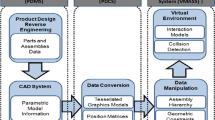Abstract
Virtual technologies are becoming more and more important in the manufacturing industry. In particular when it comes to the education of employees and production work, cognitive assistance systems offer a high potential for enhancing efficiency. The use of Virtual Reality (VR) for an assembly simulation allows for cost-effective training of employees. In such assembly simulations, however, it is essential to make the training content as realistic as possible in order to avoid unacceptable training effects. This research paper presents a technical solution of a virtual training environment that allows a physically realistic simulation of mechanical assembly operations. As part of this project a VR application was developed in which the trainee learns the assembly processes for the production of a complex mechanical component. To provide the most realistic learning experience possible, various functionalities have been implemented. A methodology has been developed which physically correctly reproduces the kinematic sequences of the components in the respective assembly processes. In addition, virtual tools such as a hammer or a torque wrench are provided to the trainee, which can be operated in a natural manner. Furthermore, interactive 3D visualizations are used to cognitively support the trainee during the assembly tasks. To validate the developed VR application, an evaluation with trainees was conducted, which showed that the VR application is more satisfying and easier to use compared to paper-based instructions. Therefore, this technical solution offers a scalable alternative for companies and schools to teach mechanical assembly tasks.
Access this chapter
Tax calculation will be finalised at checkout
Purchases are for personal use only
Similar content being viewed by others
References
Porter ME, Heppelmann JE (2017) A manager’s guide to augmented reality – why every organization needs an augmented reality strategy. Harv Bus Rev 95(6):45–57
Jayaram S, Connacher HI, Lyons KW (1997) Virtual assembly using virtual reality techniques. Comput Aid Des 29(8):575–584
Jayasekera RDMD, Xu X (2019) Assembly validation in virtual reality—a demonstrative case. Int J Adv Manufac Technol 105:3579–3592
Abidi MH, Ahmad A, El-Tamimi AM, Al-Ahmari AM (2012) Development and evaluation of a virtual assembly trainer. Proc Hum Factors Ergon Soc Ann Meet 56(1):2560–2564
Al-Ahmari AM, Abidi MH, Ahmad A, Darmoul S (2016) Development of a virtual manu-facturing assembly simulation system. Adv Mech Eng 8(3): 1–13
Abidi MH, Al-Ahmari A, Ahmad A, Ameen W, Alkhalefah H (2019) Assessment of virtual reality-based manufacturing assembly training system. Int J Adv Manufact Technol 105:3743–3759
Dwivedi P, Cline D, Joe C, Etemadpour R (2018) Manual assembly training in virtual environments. In: 18th International Conference on Advanced Learning Technologies (ICALT), pp 395–399. IEEE, Mumbai
Seth A, Vance JM, Oliver JH (2011) Virtual reality for assembly methods prototyping: a review. Virt Real 15(1):5–20
Grohmann A, Kauffeld S (2013) Evaluating training programs: development and correlates of the questionnaire for professional training evaluation. Int J Train Dev 17(2):135–155
Kirkpatrick D, Kirkpatrick J (2006) Evaluating Training Programs, 3rd edn. Berrett-Koehler Publishers, San Francisco
Venkatesh V (2000) Determinants of perceived ease of use: integrating control, intrinsic motivation, and emotion into the technology acceptance model. Inf Syst Res 11(4):342–365
Mlekus L, Bentler D, Paruzel A, Kato-Beiderwieden AL, Maier GW (2020) How to raise technology acceptance: user experience characteristics as technology-inherent determinants. Gruppe. Interaktion. Organisation. Zeitschrift für Angewandte Organisationspsychologie (GIO) 51(3):273–283
Sawilowsky SS (2009) New effect size rules of thumb. J Mod Appl Stat Meth 8(2):597–599
Acknowledgements
This research and development work is based on “AWARE”, a project of the “it’s OWL” Leading-Edge Cluster, partially funded by the German Federal Ministry of Education and Research (BMBF).
Author information
Authors and Affiliations
Corresponding author
Editor information
Editors and Affiliations
Rights and permissions
Copyright information
© 2022 The Author(s), under exclusive license to Springer Nature Switzerland AG
About this paper
Cite this paper
Dyck, F., Pilates, M., Masjutin, L., Stöcklein, J. (2022). Physically Realistic Simulation of Mechanical Assembly Operations in a Virtual Reality Training Environment. In: Auer, M.E., Bhimavaram, K.R., Yue, XG. (eds) Online Engineering and Society 4.0. REV 2021. Lecture Notes in Networks and Systems, vol 298. Springer, Cham. https://doi.org/10.1007/978-3-030-82529-4_18
Download citation
DOI: https://doi.org/10.1007/978-3-030-82529-4_18
Published:
Publisher Name: Springer, Cham
Print ISBN: 978-3-030-82528-7
Online ISBN: 978-3-030-82529-4
eBook Packages: Intelligent Technologies and RoboticsIntelligent Technologies and Robotics (R0)




